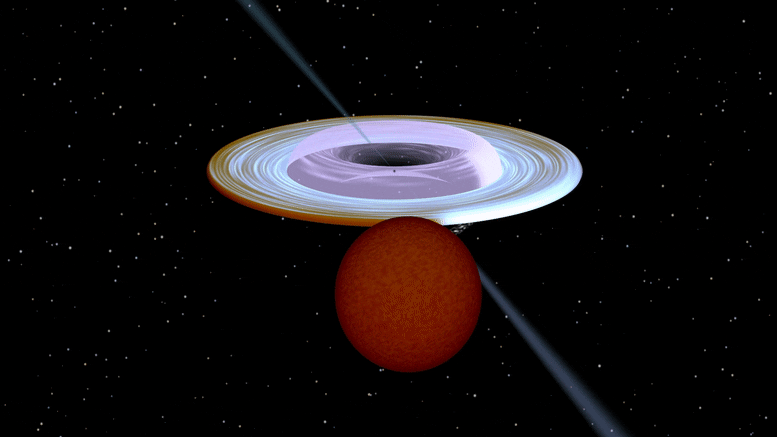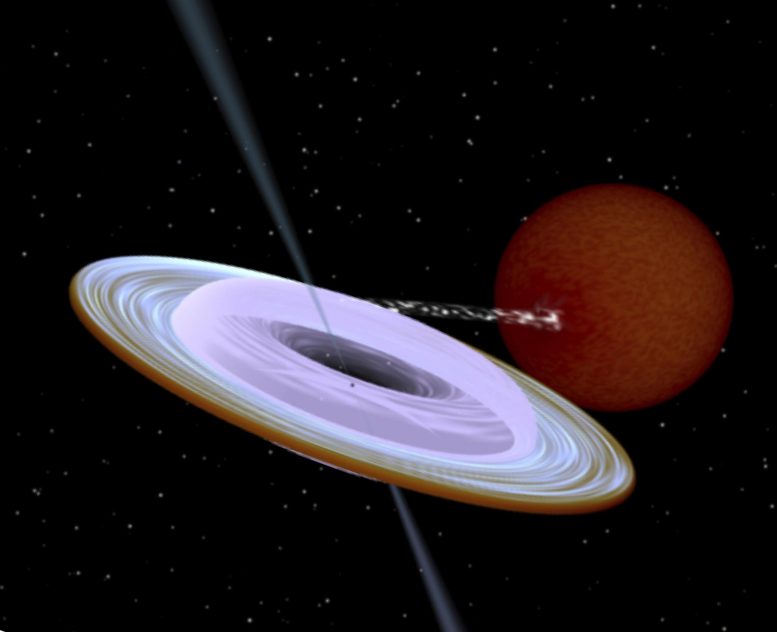
Forskare från Åbo universitet i Finland fann att rotationsaxeln för en[{” attribute=””>black hole in a binary system is tilted more than 40 degrees relative to the axis of stellar orbit. The finding challenges current theoretical models of black hole formation.
The observation by the researchers from Tuorla Observatory in Finland is the first reliable measurement that shows a large difference between the axis of rotation of a black hole and the axis of a binary system orbit. The difference between the axes measured by the researchers in a binary star system called MAXI J1820+070 was more than 40 degrees.

Artist impression of the X-ray binary system MAXI J1820+070 containing a black hole (small black dot at the center of the gaseous disk) and a companion star. A narrow jet is directed along the black hole spin axis, which is strongly misaligned from the rotation axis of the orbit. Image produced with Binsim. Credit: R. Hynes
Often for the space systems with smaller objects orbiting around the central massive body, the own rotation axis of this body is to a high degree aligned with the rotation axis of its satellites. This is true also for our solar system: the planets orbit around the Sun in a plane, which roughly coincides with the equatorial plane of the Sun. The inclination of the Sun rotation axis with respect to orbital axis of the Earth is only seven degrees.
“The expectation of alignment, to a large degree, does not hold for the bizarre objects such as black hole X-ray binaries. The black holes in these systems were formed as a result of a cosmic cataclysm – the collapse of a massive star. Now we see the black hole dragging matter from the nearby, lighter companion star orbiting around it. We see bright optical and X-ray radiation as the last sigh of the infalling material, and also radio emission from the relativistic jets expelled from the system,” says Juri Poutanen, Professor of Astronomy at the University of Turku and the lead author of the publication.
Ett konstnärsavtryck av det binära röntgensystemet MAXI J1820 + 070 som innehåller ett svart hål (en liten svart punkt i mitten av gasskivan) och en medföljande stjärna. En smal stråle riktas längs det svarta hålets rotationsaxel, som är starkt sned från omloppsbanans rotationsaxel. Bilden togs fram med en bris. Kredit: R. Hynes
Genom att följa dessa jetstrålar kunde forskarna bestämma riktningen för det svarta hålets rotationsaxel mycket exakt. När mängden gas som faller från medföljande stjärna in i det svarta hålet senare började minska kyldes systemets temperatur och en stor del av ljuset i systemet kom från ledsagarstjärnan. På så sätt kunde forskarna mäta banans lutning med hjälp av spektroskopiska tekniker och detta sammanföll ungefär med ballistikens lutning.
”För att bestämma 3D-orienteringen av omloppsbanan behöver man också känna till positionsvinkeln för systemet på himlen, vilket betyder hur systemet roterar med avseende på riktningen norr på himlen. Detta mättes med polarimetritekniker”, säger Juri Potanin.
Resultaten publicerade i Science öppnar intressanta möjligheter till studier av bildandet av svarta hål och utvecklingen av sådana system, eftersom det är svårt att få en sådan extrem ojämvikt i många scenarier av svarta håls bildning och binär evolution.
Skillnaden på mer än 40 grader mellan omloppsaxeln och det svarta hålets rotation var helt oväntad. Forskare antog ofta att denna skillnad var mycket liten när de modellerade materiens beteende i ett krökt tidsrum runt ett svart hål. Befintliga modeller är redan komplexa, och nu tvingar de nya rönen oss att lägga till en ny dimension till dem, säger Potanin.
Referens: ”Orbit-orbit black hole rotation obalans i X-ray binary MAXI J1820+070” av Guri Potanin, Alexandra Veledina, Andrei V Berdyugina, Svetlana V Berdyugina, Helen Germak, Peter J. Juncker, Gary JE Kagava, Ilya Kozenkov, Vadim Kravtsov Filippo Perola, Manisha Shrestha, Manuel A. Perez-Torres och Serge S. Tsygankov, 24 februari 2022 Tillgänglig här. att veta.
DOI: 10.1126 / science.abl4679
Huvudupptäckten gjordes med hjälp av den egenbyggda DIPol-UF-polarimetern installerad vid Northern Optical Telescope, gemensamt ägd av Åbo universitet med Århus universitet i Danmark.

”Stolt musikutövare. Passionerad resenörd. Prisbelönt webbspecialist. Amatörskapare. Kaffeevangelist.”